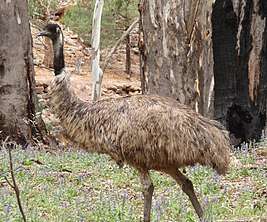Emu oil
Emu oil is an oil derived from adipose tissue harvested from certain subspecies of the emu, Dromaius novaehollandiae, a flightless bird indigenous to Australia.[1][2]

Unadulterated emu oil can vary widely in color and viscosity anywhere from an off-white creamy texture to a thin yellow liquid, depending on the diet of the emu and the refining method(s) used.[3] Industrially refined "emu grade" emu oil is composed of a minimum of 70% unsaturated fatty acids. The largest component is oleic acid, a monounsaturated omega-9 fatty acid. Emu oil also contains roughly 20% linoleic acid (an omega-6 fatty acid) and 1–2% linolenic acid (an omega-3 fatty acid).[4] Fully refined emu oil has a bland flavor.[4]
Commercial emu oil supplements are not standardized and vary widely in their potency.[5] The U.S. Food and Drug Administration highlighted emu oils in a 2009 article on "How to Spot Health Fraud", pointing out that many "pure emu oil" products are unapproved drugs.[6]
Research
As of 2019 there have been at least three randomized controlled trials in humans. A first study (n=42) suggests a trend for reduced skin toxicity for patients receiving emu oil during radiation therapy;[7] a second RCT (n=22) found that a gel containing emu oil was possibly effective as a topical treatment for acute phase Peyronie's Disease;[8] and a third study failed to show a greater efficacy for emu oil over placebo in a population of postmenopausal women with early breast cancer experiencing arthralgias following initiation of an aromatase inhibitor (n=73).[9]
See also
- Snake oil
- List of ineffective cancer treatments
- Companion animals
References
- American Emu Association FAQ
- Devantier, Alecia T; Carol, Turkington (2006). Extraordinary Jobs in Agriculture and Nature. Infobase Publishing. ISBN 978-0-8160-5854-9.
- American Emu Association - Definition of emu oil grades
- "Emu Oil Trade Rule 103" (PDF).
- Whitehouse MW, Turner AG, Davis CK, Roberts MS (1998). "Emu oil(s): A source of non-toxic transdermal anti-inflammatory agents in aboriginal medicine". Inflammopharmacology. 6 (1): 1–8. doi:10.1007/s10787-998-0001-9. PMID 17638122.
- Kurtzweil, Paula (April 30, 2009). "How to Spot Health Fraud". U.S. Food and Drug Administration. Retrieved June 29, 2009.
- Rollmann, Denise C.; Novotny, Paul J.; Petersen, Ivy A.; Garces, Yolanda I.; Bauer, Heather J.; Yan, Elizabeth S.; Wahner-Roedler, Dietlind; Vincent, Ann; Sloan, Jeff A.; Issa Laack, Nadia N. (2015-07-01). "Double-Blind, Placebo-Controlled Pilot Study of Processed Ultra Emu Oil Versus Placebo in the Prevention of Radiation Dermatitis". International Journal of Radiation Oncology, Biology, Physics. 92 (3): 650–658. doi:10.1016/j.ijrobp.2015.02.028. ISSN 1879-355X. PMID 25936812.
- Twidwell, J.; Levine, L. (March 2016). "Topical treatment for acute phase Peyronie's disease utilizing a new gel, H-100: a randomized, prospective, placebo-controlled pilot study". International Journal of Impotence Research. 28 (2): 41–45. doi:10.1038/ijir.2015.22. ISSN 1476-5489. PMID 26700214.
- Chan, Arlene; De Boer, R.; Gan, A.; Willsher, P.; Martin, R.; Zissiadis, Y.; Miller, K.; Bauwens, A.; Hastrich, D. (December 2017). "Randomized phase II placebo-controlled study to evaluate the efficacy of topical pure emu oil for joint pain related to adjuvant aromatase inhibitor use in postmenopausal women with early breast cancer: JUST (Joints Under Study)". Supportive Care in Cancer. 25 (12): 3785–3791. doi:10.1007/s00520-017-3810-9. ISSN 1433-7339. PMID 28691132.